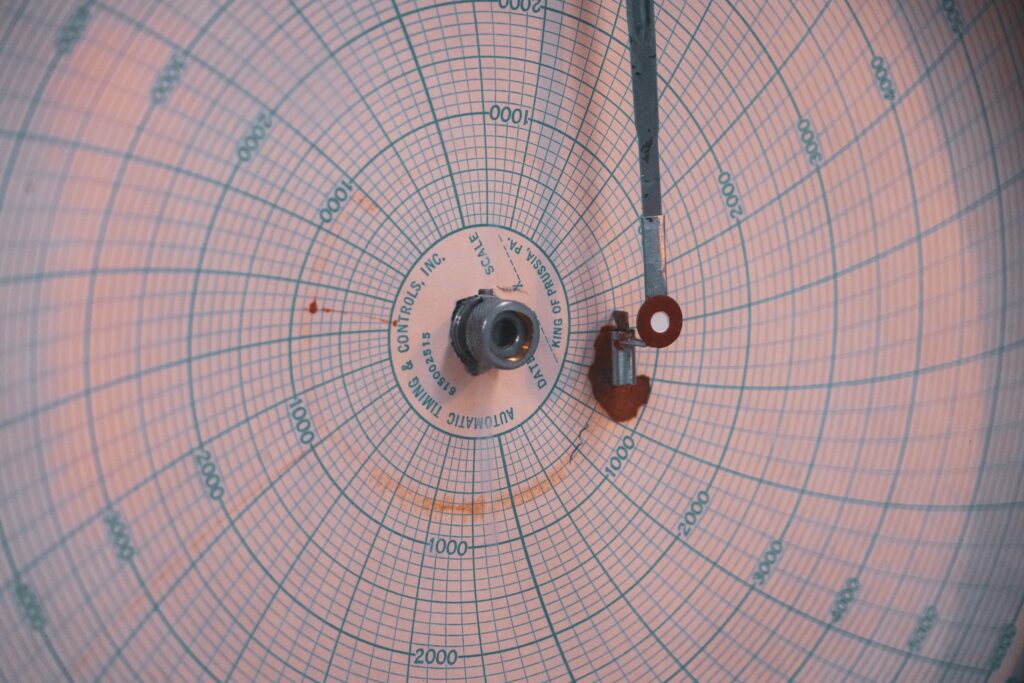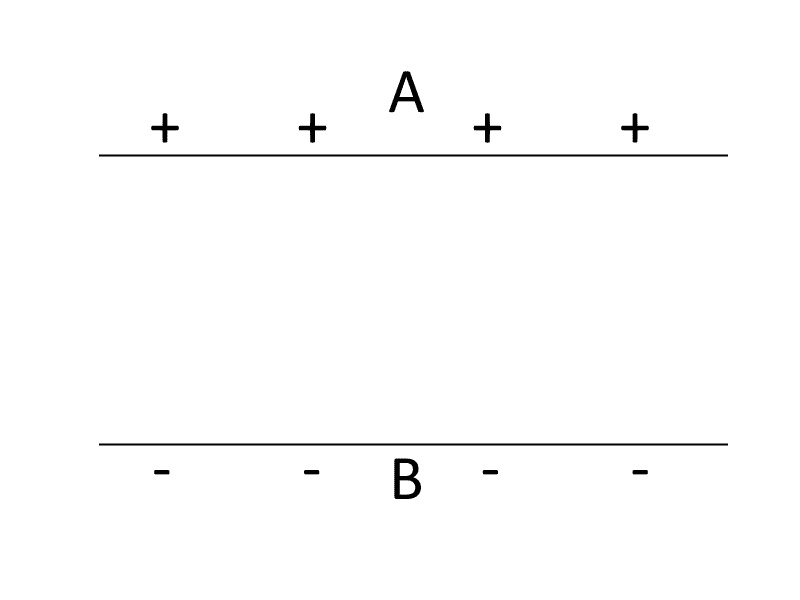Looking for some VCE Physics External Multiple Choice questions to help you revise for your Exam?
You’ve come to the right place.
Whether you’re just beginning to study or looking to complete some last minute revision, these questions will help refresh and lock in the knowledge you’ve already built.
So, let’s dive in!
VCE Physics External Multiple Choice Questions
When completing these questions, use the following values:
| Constant | Value |
|---|---|
| g | 9.81 m/s2 |
| h | 6.63 |
| c | 3.00 x 108 m/s |
Question 1
The extrasolar planet Proxima b has a diameter 30% larger than the Earth, and a mass 7% larger. The surface gravity of Proxima b is
- 15.49 m/s2
- 11.92 m/s2
- 6.21 m/s2
- 8.07 m/s2
Question 2
The image above shows two parallel plates, A and B. Which statement below best describes the Electric Field between the two plates?
- The Electric field travels from B to A, the field strength increases from B to A
- The Electric field travels from A to B, the field strength is constant
- The Electric field travels from A to B, the field strength is increases from A to B
- The Electric field travels from A to B, the field strength is decreases from A to B
Question 3
A compass uses a small, dipolar magnet to determine which direction is North. The north end of the magnet points to the north pole. Which statement best describes the Earth’s magnetic poles:
- The Earth’s so-called “North” pole is a magnetic north pole, and its “South” pole is a magnetic south pole. The magnetic field is strongest at the poles.
- The Earth’s so-called “North” pole is actually a magnetic south pole, and its “South” pole is actually a magnetic south pole. The magnetic field is strongest at the equator.
- The Earth’s so-called “North” pole is a magnetic north pole, and its “South” pole is a magnetic south pole. The magnetic field is strongest at the equator.
- The Earth’s so-called “North” pole is actually a magnetic south pole, and its “South” pole is actually a magnetic south pole. The magnetic field is strongest at the poles.
Question 4
In a DC electric motor, which statement best describes the purpose of the split-ring commutator?
- To power the motor.
- To convert electric energy into kinetic energy.
- To reverse the current in the loop and keep the coil rotating in the same direction.
- To generate the magnetic field that induces motion in the loop.
Question 5
A magnet approaches a coil with 20 turns, and over a 2 second interval the change in the magnetic field induces an average EMF of 5V. By how much does the magnetic flux change?
- 0.50 Wb
- 50.00 Wb
- 0.13 Wb
- 200 Wb
Want more questions? Check out our VCE Physics Past Exams Master List here!
Question 6
A computer uses a step down transformer that transforms 120 V to 5 V. If the power unit draws 750 W of power, what is the current through the 120 V coil?
- 0.16 A
- 31.25 A
- 150 A
- 6.25 A
Question 7
The image above shows the path of a pendulum with a mass of 30g and a 20 cm rod. If the pendulum is at rest when it is released at A, what is the speed of the pendulum at point B? (Assume that the mass of the rod is negligible)
- 1.98 m/s
- 3.92 m/s
- 15.40 m/s
- 1.40 m/s
The following information relates to questions 8 and 9.
A 500g weight is placed on a spring, causing the spring to compress by 5mm.
Question 8
What is the spring constant (K) of this spring?
- 5 N/m
- 100 N/m
- 981 N/m
- 1962 N/m
Question 9
If this spring is compressed by 10mm, how much potential energy is stored in the spring?
- 4905.00 J
- 9.81 J
- 19.62 J
- 4.91 J
The following information relates to questions 10 to 12.
For a movie stunt, a car is driven off the end of an in-construction bridge. The car has a speed of 200 km/h when it reaches the edge, which is situated 50m above the water below.
Question 10
Which of the following expressions describes the horizontal distance, d, in metres that the car has travelled t seconds after driving over the edge?
- 200 t
- 55.56 t
- 55 .56 t + 4.91 t2
- 4.91 t2
Question 11
How long does it take the car to reach the water below?
- 0.90 s
- 3.19 s
- 3.60 s
- 4.11 s
Question 12
How far does the car travel horizontally before crashing into the water?
- 177.38 m
- 638.55 m
- 200 m
- 50 m
Question 13
An 80cm guitar string plays the note A4 — which has a frequency of 432 Hz. Assuming that this is the first harmonic, what is the wave speed as the wave travels up and down the guitar string?
- 345.6 m/s
- 34.6 m/s
- 2.3 m/s
- 691.2 m/s
Question 14
It is well known that water has a higher refractive index than air. For an observer looking into a stream from above, which of the following is true?
- The angle of incidence is larger than the angle of refraction
- The average speed of light is faster in the water.
- The angle of refraction is larger than the angle of incidence.
- The light that passes into the observer’s eyes bends towards the normal as it leaves the stream.
Question 15
Which of the following statements about Young’s double slit experiment is true?
- The dispersion of light between the slits creates an interference pattern.
- The interference at any point depends on the path difference between the two points.
- The principle of superposition ensures that the frequencies of light through each slit is the same.
- The centre of the interference pattern will display destructive interference.
Question 16
A plane with mass 575,000 kg is travelling at a speed of 250 m/s. What is its de Broglie wavelength?
- 9.53 x 10-26 m
- 1.52 x 10-30 m
- 4.61 x 10-42 m
- 2.88 x 10-37 m
Question 17
Which of the following statements best describes the conclusions that can be drawn from observation of the photoelectric effect?
- It proved the corpuscular theory of light.
- It supports the dual nature of light.
- It disproved the wave theory of light.
- It supports the wave theory of light.
Question 18
Consider four different wavelengths of light: radio waves, infrared light, x-rays and gamma rays. Which of the following shows these types of light in ascending order of wavelength?
- X- rays < gamma rays < infrared < radio waves
- gamma rays < X-rays < infrared < radio waves
- X-rays < gamma rays < radio waves < infrared
- Radio waves < infrared < X-rays < gamma rays
Question 19
An electron is placed, at rest, in a constant magnetic field. Which best describes the path of the electron?
- It will orbit clockwise
- It will orbit counter-clockwise
- It will remain stationary
- It will travel into the page
Question 20
Considering the diagram above, assume that the electron now has initial velocity to the right. Which best describes the path of the electron under these circumstances?
- It will orbit clockwise
- It will orbit counter-clockwise
- It will remain stationary
- It will travel into the page
Want to ace your Scientific Poster assessment for VCE Physics? Check out our ultimate guide here!
Question 21
The star Beta Minotaurai converts mass to energy through fusion at a rate of 7.8 x 107 kg/s. How much power does it produce?
- 3.51 x 1024 W
- 7.02 x 1024 W
- 2.34 x 1016 W
- 1.83 x 1024 W
Question 22
A positron is travelling through space at a velocity of 1.68 x 108 m/s. What is the Lorentz factor of this positron?
- 0.828
- 1.21
- 0.56
- 0.31
Question 23
The following information is relevant for the VCE Physics External Multiple Choice Questions 23 – 25.
A rural power line with a resistance of 5 Ohms transmits 50 kW of power over a distance of 200 km. About 20% of this power is lost during transmission.
How much current is travelling through the power line?
- 2000 A
- 50,000 A
- 44.7 A
- 6.69 A
Question 24
If a step up transformer is utilised at the beginning of the power line with 20 coils in the primary coil and 2400 turns in the secondary coil, what is the input voltage?
- 7476.7 V
- 62.3 V
- 12.5 V
- 38.3 V
Question 25
Which of the following strategies will decrease the power loss during transmission?
- Increase the number of coils in the secondary coil of the transformer, thereby decreasing the voltage in the transmission line.
- Increase the number of coils in the primary coil of the transformer, thereby decreasing the voltage in the transmission line.
- Increase the number of coils in the secondary coil of the transformer, thereby increasing the voltage in the transmission line.
- Increase the number of coils in the primary coil of the transformer, thereby increasing the voltage in the transmission line.
Finished your VCE Physics External Multiple Choice questions? Check out our top tips to acing your end of year Physics exam here and here!
Answers for VCE Physics External Multiple Choice Questions
Click here to download the solutions to the 25 practice questions above!
Check out our VCE Physics External Short Answer questions here!
And, you’ve finished all the questions!
Check out some extra resources for VCE Physics here:
- The Ultimate Guide to Creating a Scientific Poster for VCE Physics
- VCE Physics Past Exams Master List
- The Ultimate 7 Day Study Plan for Your VCE Physics Exam
- What to Do the Night Before Your VCE Physics Exam
- The Ultimate Guide to Units 1 and 2 VCE Physics
- The Ultimate Guide to Units 3 and 4 VCE Physics
Are you looking for some extra help with preparing for your VCE Physics external assessments?
We have an incredible team of VCE tutors and mentors! We have expert VCE tutors all across Glen Waverley! Get booked in today!
VCE Physics is no easy subject! Get expert VCE tutoring support in the Cranbourne area!
We can help you master the VCE Physics study design and ace your upcoming VCE assessments with personalised lessons conducted one-on-one in your home or online!
We’ve supported over 8,000 students over the last 11 years, and on average our students score mark improvements of over 20%!
To find out more and get started with an inspirational VCE tutor and mentor, get in touch today or give us a ring on 1300 267 888!
Scott McColl is a content writer with Art of Smart and a Civil Engineering student at Monash University. In between working and studying, Scott enjoys playing music and working on programming projects.







